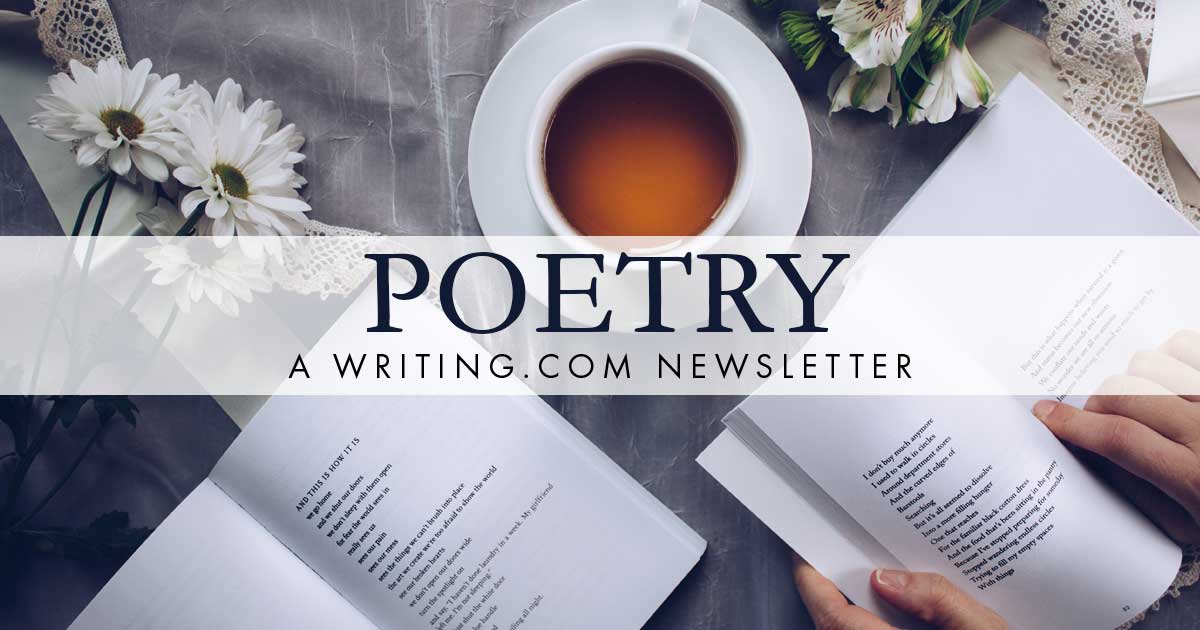This week: To Rhyme or Not to Rhyme! Edited by: Lilli ☕  
More Newsletters By This Editor 
![Table of Contents [#401437]
Table of Contents](https://www.Writing.Com/main/trans.gif) ![Table of Contents [#401437]
Table of Contents Table of Contents](/main/images/action/display/ver/1709303267/item_id/401437.png)
1. About this Newsletter
2. A Word from our Sponsor
3. Letter from the Editor
4. Editor's Picks
5. A Word from Writing.Com
6. Ask & Answer
7. Removal instructions
![About This Newsletter [#401439]
About This Newsletter](https://www.Writing.Com/main/trans.gif) ![About This Newsletter [#401439]
About This Newsletter About This Newsletter](https://www.writing.com/main/images/action/display/ver/1709303676/item_id/401439.png)
"I'm tired of love; I'm still more tired of rhyme;
but money gives me pleasure all the time."
~ Hilaire Belloc
"My favorite rhymes are sort of half-rhymes where you might just get the vowel sound the same, but it's not really a true rhyme. That gives you far more flexibility to capture the feeling you're trying to express. But sometimes it's best not to have any rhyme."
~ Conor Oberst
"My mother was always fascinated with the fact that I could rhyme so much stuff."
~ Dolly Parton
|
![Letter from the editor [#401442]
Letter from the editor](https://www.Writing.Com/main/trans.gif) ![Letter from the editor [#401442]
Letter from the editor Letter from the editor](https://www.writing.com/main/images/action/display/ver/1709303784/item_id/401442.png)
In the vast, ever-evolving landscape of poetry, traditional structures sometimes take a backseat to free verse and experimental forms. Yet, one element keeps its power, musicality, and fundamental importance: rhyme.
More than just a pleasant acoustic effect, the skillful use of rhyme is a cornerstone of poetic artistry that enhances rhythm, meaning, and memorability.
 The Music of Words: Rhythm and Structure The Music of Words: Rhythm and Structure
Rhyme and rhythm are intrinsically linked. When poets employ a consistent rhyme scheme (like AABB, ABAB, or AABB CC DD), they establish an expected musicality for the reader and listener.
Creates Cohesion: Rhyme ties lines together, making a stanza feel like a complete, unified thought or a self-contained musical unit.
Emphasizes Meter: In metered verse (like iambic pentameter), rhyme often marks the end of a line, providing a satisfying sense of finality and reinforcing the underlying beat.
Builds Anticipation: The brain subconsciously anticipates the second line of a rhyming pair, creating a sense of cognitive satisfaction when the pattern meets that expectation.
 The Power of Memory: Mnemonic Devices The Power of Memory: Mnemonic Devices
Before the age of mass printing, poetry was primarily an oral tradition. Rhyme was not merely decorative; it was a crucial tool for preservation.
Did You Know? Rhyme acts as a powerful mnemonic device. Think of nursery rhymes, folk songs, or even advertising jingles—their use of rhyme is why they stick in your head so easily. This makes the poet’s message more portable and enduring.
 Shaping Meaning: Focus and Contrast Shaping Meaning: Focus and Contrast
A well-placed rhyme can draw the reader’s attention to specific words, thus sharpening the poem’s thematic focus.
When two crucial thematic words rhyme (e.g., truth and youth, or light and night), the rhyme reinforces their relationship and amplifies their significance.
Creating Irony or Humor: Unexpected or forced rhymes (often used in satirical verse) can create a jarring effect that underlines a sense of awkwardness, irony, or comedic intent.
Providing Resolution: A concluding rhyming couplet often delivers the poem's central message, or “punchline,” offering a concise, memorable summary.
 A Call to Action: Mastering the Art A Call to Action: Mastering the Art
While free verse offers boundless expressive freedom, the discipline of writing with rhyme challenges the poet to choose words more deliberately and creatively. It demands that the poet find the perfect word that satisfies both the meaning and the sound.
If you are a poet or an aspiring one, don’t dismiss rhyme as old-fashioned. Engage with it:
Read the Masters: Explore the works of Shakespeare, Robert Frost, and Emily Dickinson to see how they use rhyme to elevate simple language into profound art.
Experiment with Schemes: Try writing a sonnet (ABAB CDCD EFEF GG) or a simple ballad (ABCB) to practice fitting your ideas into a formal structure.
Vary Your Rhymes: Move beyond simple full rhymes (cat/hat) and explore slant rhymes (shape/keep) or eye rhymes (love/move) for subtler musical effects.
Rhyme is a magnificent tool that bridges the gap between sound and sense. By honoring its potential, contemporary poets can connect to a tradition of musicality that has captivated readers for centuries, ensuring their words not only speak but sing. |
![Editor's Picks [#401445]
Editor's Picks](https://www.Writing.Com/main/trans.gif) ![Editor's Picks [#401445]
Editor's Picks Editor's Picks](https://www.writing.com/main/images/action/display/ver/1709303830/item_id/401445.png)
| |  | Tomorrow  (E) (E)
A poem that came to me as I was thinking about what to do after I graduate.
#1858817 by Mindertwenty   |
|
![Word From Writing.Com [#401447]
Word from Writing.Com](https://www.Writing.Com/main/trans.gif) ![Word From Writing.Com [#401447]
Word from Writing.Com Word from Writing.Com](https://www.writing.com/main/images/action/display/ver/1709303874/item_id/401447.png)
Have an opinion on what you've read here today? Then send the Editor feedback! Find an item that you think would be perfect for showcasing here? Submit it for consideration in the newsletter!
https://www.Writing.Com/go/nl_form
![Ask & Answer [#401448]
Ask & Answer](https://www.Writing.Com/main/trans.gif) ![Ask & Answer [#401448]
Ask & Answer Ask & Answer](https://www.writing.com/main/images/action/display/ver/1709303902/item_id/401448.png)
![Unsubscribe [#401452]
Removal Instructions](https://www.Writing.Com/main/trans.gif) ![Unsubscribe [#401452]
Removal Instructions Removal Instructions](https://www.writing.com/main/images/action/display/ver/1709303960/item_id/401452.png)
To stop receiving this newsletter, click here for your newsletter subscription list. Simply uncheck the box next to any newsletter(s) you wish to cancel and then click to "Submit Changes". You can edit your subscriptions at any time.
|
